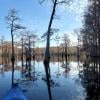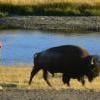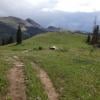MarkBC,
Thanks for the link. I left RicoV some questions. I just looked up refectix and it only has an R value of around 1.7 (horizontal) or less depending on orientation. My degree is in Physics and I work with reflective mylar blanketing material all the time in my job (Space Based Earth Resources and Weather Instruments).
While I am not a Thermodynamacist I believe that in general there are three forms of heat transfer, radiative, convective and conductive. Heat transfer is most efficient by convection, then by conduction; radiation is the least efficient and slowest means of heat transfer.
A vacuum inhibits both convection and conduction and so is a good insulator. In vacuum, radiation is the dominant heat transfer mechanism and that is why we use reflective blankets made of metallized mylar on spacecraft (sometimes many layers thick since the radiation path is layer to layer and the vacuum between layers helps the insulation efficiency).
Metal is a great heat conductor and in an Earth ambient (non-vacuum) environment both conduction and convection far and away dominate over radiation. Therefore, the low R value for Reflectix does not surprise me and I think it is not a very good insulation material. Further the Refectix metallized metal surface may actually be helping the heat transfer via conduction into and through the material.
What is needed is a good convection and conduction insulator. Again, in an Earth Ambient environment that means dead air space, trapped volumes of air to minimize convection, between low conductive materials. This is why closed cell foam has such a good R rating as compared to fiberglass batts and why thicker is better (as we all know).
So I think your path to a different material is appropriate. Bubble wrap is a natural thought but there are conductive paths at the edges of all the bubble cells where it has been heat sealed to trap air. To be sure it is better than nothing just not very efficient.
I think some kind of open cell very flexible foam or even a very flexible but thin layer, say 1/2" to 3/4" of closed cell foam that is flexible (if such a thing exists) that is enclosed between two layers of some durable material say polyurethane would be far superior to fleece. Oh wait, I just described a thermarest type mattress (they use open cell foam). Open cell is better considering transport because, unlike closed cell foam, the air can be squeezed out of it.
So I think a superior approach here is something equivalent to a large thermarest mattress that can be wrapped around and attached to the camper sides (even the top) using velcro and/or bungies. When it is removed it can be compressed, as it is rolled up, to squeeze out the air to make it less bulky for carrying and storage just like a backpacking mattress.
My guess is that an R-value for such an insulating wrap might be 3 or greater. That is about 2 times what reflectix can provide (BTW: as the Reflectix web site says, just doubling up Reflectix doesn't help much.
I have no idea how difficult or costly it would be to make such a thing but i'll bet there is a good reason that a thermarest type mattress costs $60 - $200 depending on size and thickness. Scaling to a camper I'm guessing that would be the equivalent of 6 to 8 mattresses so a price of $800 or more would not surprise me. Maybe a bit cheaper if there were say only four panels.
For those of us who camp in places that get very warm or very cold $800 or so may not be too much to pay for more comfort.
I will try to engage one of my thermodynamic colleagues on this question and see what he/she thinks about it.
Regards,
Craig

















